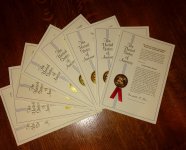Omid
Well-known member

Read your pdf with interest Omid. I would guess (not having looked through your previous posts) your background is as a hunter? I agree that binocular development is probably now led by/directed towards the birding rather than the hunting community, and that the pace of improvement has tapered off and that future improvements in pure optical quality (transmission, resolution etc) are likely to be incremental (unless major disruptive technology intervenes, of course).
Thank you for reading my slides. Yes the improvements in sports optics have been very incremental and that, too, is tapering off. Now, speaking of disruptive technology, I have made some innovations myself:
a) Binoculars without a critical eye relief. The exit pupil is located at the eyepiece and is as large as the eyepiece. This way, the entire eyepiece shows an image when viewed from behind the binoculars. The image is visible even if you position your eyes on an off-axis position.
b) Binoculars with convergent optical axis capable of extreme close focus (say 20 cm).
c) Binoculars with divergent optical axis providing about 30% or more "binocular" field of view.
I once had a topic about my inventions here on Birdforum. I can't post there as it says the topic is too old to reply too. I might open a new one and present my projects if the forum members are interested.
Regards,
-Omid






